14010 Smoketown Rd., Suite 103
Woodbridge, VA 22192 (703) 583-5959
(703) 583-5995
46440 Benedict Dr., Suite 209
Sterling, VA 20164 (703) 444-9555
(703) 444-1190
1657 Crofton Blvd., Suite 201
Crofton, MD 21114 (410) 721-4505
(410) 721-2394
43 Old Solomons Island Rd, Suite 102
Annapolis, MD 21401 (410) 263-3100
(410) 263-7380
4475 Regency Pl., Suite 204
White Plains, MD 20695 (301) 645-1406
(301) 645-0997
MENU
Home » MiniBunion Surgery
Bunions can be painful and unsightly. One of the main reasons bunion-sufferers avoid surgery is concerns about how long they will be off their feet unable to take care of themselves or their responsibilities.
This is why CrossRoads Extremity Systems developed the miniBunion™ procedure; a minimally-invasive 3D bunion surgery technique to repair bunions. Unlike traditional procedures, the miniBunion™ technique requires a tiny incision 2 to 4-times smaller than a standard technique and requires much less trauma to the soft-tissues surrounding the toes. This minimally-invasive technique spares the blood supply to the bones and allows a smaller scar and faster recovery.
The miniBunion™ scar is not only small, it is in a location that is difficult for anyone to see. Unlike most bunion procedures where the incision is on the top of the foot, the miniBunion™ incision is on the inner side of the foot. This location results in a scar that is basically invisible during day-to-day activities.
With the miniBunion™ 3D bunion surgery, your surgeon can correctly align your toe in all 3 dimensions while preserving the toe joint and preserving the surrounding soft tissue. Since the surgeon is not invading the toe joint and not fusing the joint, many patients are able to have a walking recovery.
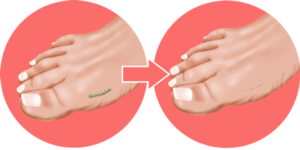
Although it depends on surgeon recommendations and patient factors, many patients walk immediately in a special postoperative shoe.
The pain from recovery depends greatly on the pain tolerance of the patient. However, surgeons who utilize the miniBunion™ technique report their patients are in less pain than would be expected from traditional bunion surgery. Click here to find a foot doctor near you.
Covered by Insurance!
Bunion correction is a very commonly insured surgical procedure. Although miniBunion™ is a new minimally-invasive procedure, it is classified as a bunion correction procedure and is therefore covered by most insurance policies. Please check with your foot doctor to see which insurance they accept.
The miniBunion™ system is a minimally-invasive surgical technique for implanting a micro-titanium implant. This patent-pending implant has been designed to provide immediate stability to a bunion patient’s foot to allow a fast return to activity.
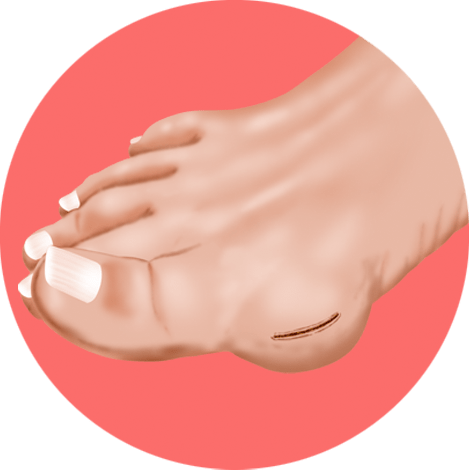
Step 1: A small incision is made on side of the foot.
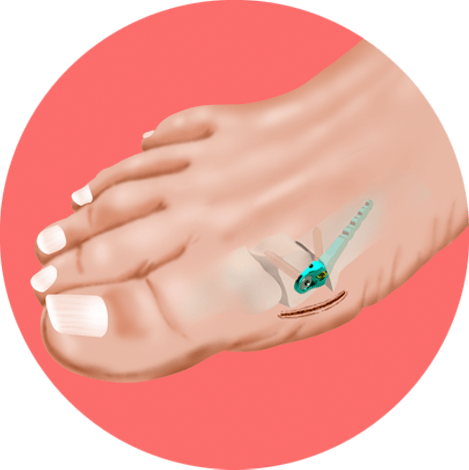
Step 2: Toe is aligned in 3 Dimensions and secured with micro-implant.
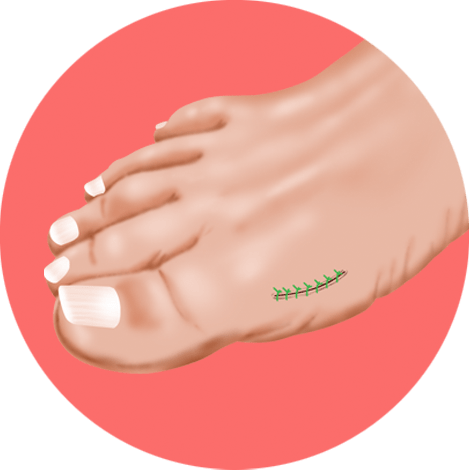
Step 3: Incision is stitched closed.
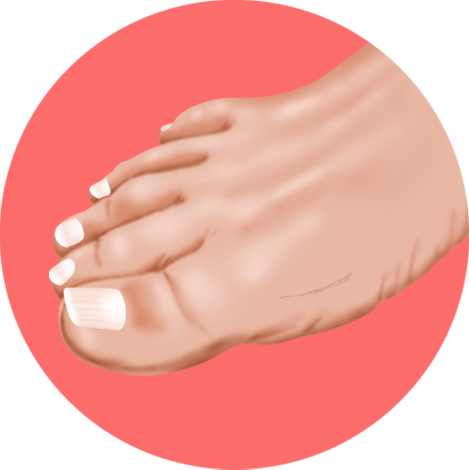
Step 4: Stitches are removed. Small scar fades away.
The anesthesiologist will put patients completely asleep or patients can be awake with an anesthetic applied to the nerves in the leg to prevent any pain during the surgery. Next, a sterile cover will be placed over the patient, but the leg will be exposed and thoroughly washed with a sterile surgical washing solution.
A small incision, generally ½ inch – 1 inch, is made on the side of the foot. The bone is realigned in all 3 dimensions with surgical instruments and the miniBunion™ implant is attached to the bone to hold the bone in the proper 3D alignment. The incision is then closed with suture.
Although the miniBunion™ technique is minimally-invasive, it still involves the risks of a standard surgical procedure.
There are several other more-invasive, traditional options for bunion correction, that are not our minimally invasive bunion surgery.
This procedure generally involves a 2 or 3 inch incision and quite a bit of soft-tissue dissection to allow the surgeon to visualize the bone to make bone resections. In this procedure, the lower end of the metatarsal (longest bone of the big toe) is separated from the shaft of the bone by making a chevron (v-shaped) resection with a surgical saw. The tip of the metatarsal is then shifted to a better position to reduce the bunion. A surgical plate or screws is then used to reattach the tip of the bone to the metatarsal and keep it in the new alignment.
This procedure generally requires a longer incision than the miniBunion™. In foot surgery, minimally-invasive procedures with smaller incisions have resulted in less infections. Additionally, recovery after traditional bunion surgery requires about six to eight weeks of rehabilitation.

The Lapidus is an excellent procedure for more severe bunions, but it is a more aggressive surgery that requires more bone resection and large incisions on the top of the foot. In this procedure, the entire metatarsal is rotated into a new position and secured with one or two metal surgical plates and screws.
Recovery from the Lapidus procedure frequently requires the patient to be non-weight bearing for four weeks after surgery in a postoperative boot; followed by four weeks of protected weight bearing in the boot.

Monday:
8:30 am-5:00 pm
Tuesday:
7:30 am-5:00 pm
Wednesday:
8:30 am-5:00 pm
Thursday:
8:30 am-5:00 pm
Friday:
8:00 am-2:00 pm
Saturday:
Select Saturdays 8:30 am - 12:30 pm
Sunday:
Closed
Monday:
8:30 am-5:00 pm
Tuesday:
7:30 am-3:30 pm
Wednesday:
8:30 am-5:00 pm
Thursday:
9:30 am-6:00 pm
Friday:
8:30 am-1:00 pm
Saturday:
Select Saturdays 8:30 am - 12:30 pm
Sunday:
Closed
Monday:
8:30 am-5:00 pm
Tuesday:
8:30 am-5:00 pm
Wednesday:
8:30 am-5:00 pm
Thursday:
8:30 am-3:00 pm
Friday:
8:00 am-2:00 pm
Saturday:
Closed
Sunday:
Closed
Monday:
8:30 am-4:30 pm
Tuesday:
8:30 am-4:30 pm
Wednesday:
8:30 am-4:30 pm
Thursday:
8:30 am-4:30 pm
Friday:
8:30 am-3:00 pm
Saturday:
Closed
Sunday:
Closed
Monday:
8:30 am-5:00 pm
Tuesday:
8:30 am-5:00 pm
Wednesday:
8:30 am-5:00 pm
Thursday:
7:30 am-3:30 pm
Friday:
9:00 am-12:00 pm
Saturday:
Closed
Sunday:
Closed
Monday:
7:30 am-3:00 pm
Tuesday:
8:00 am-4:30 pm
Wednesday:
8:00 am-4:30 pm
Thursday:
8:00 am-12:00 pm
Friday:
8:00 am-4:30 pm
Saturday:
Closed
Sunday:
Closed
Copyright © 2025 Potomac Podiatry Group | Site Map